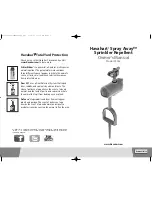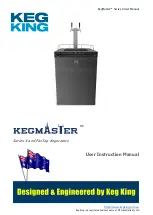
Page 12
FIGURE 11 - Dirty Filter
Pressure Switch
Set screw (on
front of switch)
must be
manually
adjusted after
system is in
operation.
Negative pressure connection is
toward the "back or bottom"
of the switch (senses blower side
of filters)
Positive pressure connection is
toward the "front or top" of the
switch (senses air inlet side of filters)
FIGURE 10 - Remote Console Dimensions
Dirty Filter Light
2-3/8
(60)
6 (152)
5-15/32 (139)
1-5/16 (33)
1-3/32 (28)
4-7/16
(113)
1-3/32 (28)
FIGURE 10 - Technical Data of the Remote Console (Variations depend on options selected; consult custom wiring diagram for
controls and to determine wiring required.)
Control Qty of Temperature Potentiometer
Dimensions - inches (mm)
Switch Lights*
Selector**
*** L****
H****
D
Yes
3
Yes
No
10-3/4 (273) 7-5/8 (194) 2-5/8 (67)
Yes
3
No
No
10-3/4 (273) 7-5/8 (194) 2-5/8 (67)
Yes
3
Yes
Yes
15-3/4 (400) 7-5/8 (194) 2-5/8 (67)
Yes
3
No
Yes
10-3/4 (273) 7-5/8 (194) 2-5/8 (67)
Yes
4
Yes
No
15-3/4 (400) 7-5/8 (194) 2-5/8 (67)
Yes
4
No
Yes
15-3/4 (400) 7-5/8 (194) 2-5/8 (67)
Yes
4
Yes
Yes
15-3/4 (400) 7-5/8 (194) 2-5/8 (67)
Yes
4
No
No
15-3/4 (400) 7-5/8 (194) 2-5/8 (67)
* 3 - Blower On, Burner On, and Safety Lockout on both RC13 and RC14;
4th light is Dirty Filter Indicator on Option RC14 only
** On the console with Gas Control Options AG 31, 32, 33, 35, 47, or 48
*** On the console with Air Control Options AR19 or AR22
**** Subtract 1" (25mm) when recessing
Locations of Knockout
Holes (dimensions to
centerlines)
When a console with a dirty filter indicator is selected, the remote console
includes a fourth light (dirty filter indicator light). The light is activated by an
adjustable, single-pole/normally open differential pressure switch that senses
air pressure across the filter bank. There are field-installation procedures that
must be done for the proper operation of the dirty filter indicator light.
10. Electrical Supply, Connections and Controls (cont'd)
Dirty Filter Light
Installation Instructions
o
Before the system is operating, connect the sensing tubes from the
switch to their sensing locations in the field-installed filter cabinet. (Cabi-
net installation instructions are in Paragraph 15.)
1) Run the tubes through the holes in the cabinet wall. Pull gently to
extend the tubing to its entire length without stress.
2) Position the tubing approximately at the center of the height of the filter
rack.
3) Identify the tube connected to the positive connection on the switch
(FIGURE 11) as the positive pressure tube. Determine the length of
tubing required to attach the positive pressure tube so that it will sense
pressure at the inlet side of the filter rack.
Identify the tube connected to the negative connection on the switch (FIG-
URE 11) as the negative pressure tube. Determine the length of tubing
required to attach the negative pressure tube so that it will sense the
pressure at the blower side of the filter rack.
(NOTE: Tubing shipped is the same length for all sizes of systems; cut to
the appropriate length for the smaller systems.)
4) If required, cut the tubing to the proper lengths. Using the clamps
provided, attach the ends of the tubing to the filter rack at about center
height being careful not to kink or compress the tubing.
o
After the system is operating, the filter switch must be manually set.
With clean filters in place, blower doors closed, and blower in operation,
increase the pressure setting by adjusting the set screw on the switch













































